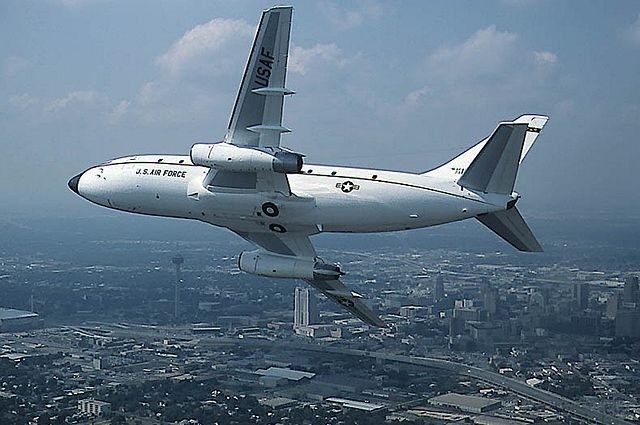Boeing 737
Summary
| Category | Military Transport Aircraft |
| Origin country | 🇺🇸 United States |
| Manufacturer | Boeing |
| First flight | 9 April 1967 |
| Year introduced | 1968 |
| Number produced | 11535 units |
| Average unit price | $115 million |
Description
Developed to supplement the Boeing 727 on short and thin routes, preliminary design work began on May 11, 1964, based on research that indicated a market for a fifty to sixty passenger airliner flying routes of 50 to 1,000 miles (100 to 1,600 km). To expedite development, Boeing used 60% of the structure and systems of the existing 727, particularly the fuselage, which differs in length only. The initial 737-100 made its first flight on April 9, 1967, piloted by Brien Wygle and Lew Wallick, and was certified for commercial flight on December 15, 1967. Lufthansa became the launch customer on February 19, 1965, with an order for 21 aircraft, worth $67 million (~$494 million in 2023). It entered service with them in February 1968. As of March 2025, 16,805 Boeing 737s have been ordered and 12,030 delivered. Initially, its main competitor was the McDonnell Douglas DC-9, followed by its MD-80/MD-90 derivatives. The 737 MAX, designed to compete with the A320neo, was grounded worldwide between March 2019 and November 2020 following two fatal crashes.
The Boeing 737 design is rooted in the pre-existing 707 and 727, sharing their fuselage cross-section and nose design. Initial models featured "eyebrow windows" above the cockpit glareshield, a feature inherited from the 707 and 727, though these were phased out by 2004. The airframe was intentionally designed to sit low to the ground, a feature suited to smaller airports of the 1960s, but one that posed challenges later on as larger, more efficient engines were introduced. The main landing gear, situated under the wings at mid-cabin, retracts into wheel wells in the aircraft's belly, with partial doors and "brush-like" seals to smooth airflow; the sides of the tires remain exposed during flight, their aerodynamic profile completed by hub caps crucial for interfacing with the anti-skid brake system through ground speed sensors. Steel landing gear brakes were supplanted by lighter Messier-Bugatti carbon brakes on newer NG models beginning in 2008. Early 737 models also didn't include fuel dump systems.
The Boeing 737 has seen widespread operational use across the globe. Lufthansa was the first to put the 737-100 into service in February 1968, marking the first instance of a non-American airline launching a new Boeing aircraft. The U.S. Air Force adopted modified 737-200s, designated as T-43s, for training aircraft navigators, and later, some were converted into CT-43s for passenger transport. Furthermore, the Indonesian Air Force utilized modified 737-200s as maritime reconnaissance and transport aircraft, equipped with SLAMMAR radar systems. By March 2008, the final 737-200s in scheduled passenger service in the U.S. were phased out. The 737-200's short-field capabilities led to the development of the "Unpaved Strip Kit", reducing the risk of foreign object damage when operating from remote or unpaved runways, and in 2013 the global 737 fleet had completed more than 184 million flights over 264 million block hours since its entry into service.
The Boeing 737 is primarily a civilian airliner and lacks specific offensive armament configurations. However, military variants such as the P-8 Poseidon, based on the 737-800ERX, are equipped with torpedoes and Harpoon anti-ship missiles for anti-submarine and anti-surface warfare roles and can also deploy sonobuoys. Conversely, the military T-43 versions are modified 737-200s primarily used for training navigators and are not configured for combat. While Boeing Business Jet versions and government-operated 737s may incorporate defensive systems in some instances, these are exceptions, and the standard commercial 737 aircraft does not possess any offensive or defensive weaponry.
Main Variants:
-
737-100: The initial and smallest variant of the 737 family, it entered service with Lufthansa in February 1968.
-
737-200: This model was a 737-100 with an extended fuselage, first ordered by United Airlines and entering service in April 1968.
-
737-300: As the first major revision of the 737, it was launched in 1979, increasing capacity and range while retaining commonality with previous variants.
-
737-400: Launched in 1985, it stretched the fuselage of the 737-300 to further increase passenger capacity, filling the gap between the 737-300 and the 757-200.
-
737-500: Offered as a direct replacement for the 737-200, it incorporated the improvements of the 737 Classic series and allowed for more economical longer routes with fewer passengers.
Technical specifications
| Version: T-43A Bobcat | |
|---|---|
| Maximum speed | 904 km/h (562 mph) |
| Wing area | 91 m² (979.5 sqft) |
| Wingspan | 28 m (91.9 ft) |
| Height | 11 m (36.1 ft) |
| Length | 30 m (98.4 ft) |
| Service ceiling | 11,278 m (37,001 ft) |
| Empty weight | 29,071 kg (64,091 lbs) |
| Max. takeoff weight | 52,163 kg (115,000 lbs) |
| Powerplant | 2 x turbojets Pratt & Whitney JT8D-9A delivering 6577 kgf each |
Current operating countries
| Country | Units | ||
|---|---|---|---|

|
United States | 141 (+29) | |

|
Australia | 18 (+2) | |

|
India | 14 | |

|
South Korea | 10 | |

|
United Kingdom | 9 (+3) | |

|
Colombia | 5 | |

|
Indonesia | 5 | |

|
Norway | 5 | |

|
Turkey | 4 | |

|
China | 2 | |
| 🇨🇩 | Congo Democratic Republic | 2 | |

|
Chile | 1 | |

|
Ecuador | 1 | |

|
Canada | 0 (+16) | |

|
Germany | 0 (+8) | |

|
New Zealand | 0 (+4) | |
All operators
